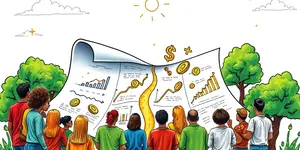In the complex world of economics, two fundamental objectives often stir debate and shape policy: economic stability and economic growth. Though related, each concept plays a distinct role in fostering a healthy, resilient society.
Defining Economic Stability and Growth
Economic stability means the absence of excessive macroeconomic fluctuations, characterized by low inflation, steady output, predictable employment, and manageable financial cycles. When stability prevails, households and businesses can plan with confidence, knowing that sudden shocks are unlikely to derail their activities.
Economic growth refers to the increase in real GDP output, the quantitative expansion of goods and services an economy produces. Growth can be rapid, moderate, or even negative, depending on factors like productivity gains, technological innovation, and consumer demand.
Measuring Stability and Growth
Policymakers and analysts track various indicators to assess both stability and growth. While growth is often captured by a single headline figure—the annual real GDP growth rate—stability requires a suite of metrics to gauge volatility and resilience.
This table highlights how each objective demands specific data points and analytical techniques to capture the full picture.
Causes and Policy Tools
Both stability and growth flourish under sound fiscal and monetary policy, yet each goal also requires targeted approaches. Stability demands mechanisms that dampen cycles and prevent sudden shifts, while growth relies on investments and innovation.
- Monetary tools: adjusting interest rates, controlling money supply
- Fiscal measures: government spending, taxation adjustments, automatic stabilizers
- Structural reforms: regulation for oversight, infrastructure and education investments
By deploying these tools judiciously, governments can foster a balanced environment where predictability and expansion coexist.
Historical Evidence and Examples
Past decades illustrate the evolution of economic volatility. Between 1920 and 1960, production growth rates swung from a high of 62% to a low of -33.7%, signaling pronounced instability. From 1961 to 2019, those extremes narrowed—peaks of 13.4% and troughs of -15.3%—reflecting improved frameworks and institutions designed to mitigate shocks.
After the 2008 financial crisis, central banks and fiscal authorities focused intensely on stability to prevent another severe downturn. These efforts, while not eliminating all fluctuations, succeeded in reducing the frequency and depth of recessions in many advanced economies.
Trade-offs, Relationship, and Synergy
A dynamic tension exists between stability and growth. Rapid expansion can lead to overheating, inflationary pressures, and asset bubbles, while an excessive focus on stability may dampen entrepreneurial risk-taking and innovation. Yet, history shows that with sustainable long-term growth pathways, economies can achieve both objectives in harmony.
Countries like Germany, Switzerland, and post-1960s Japan exemplify nations that balanced steady economic cycles with robust output gains, leveraging prudent policy frameworks and resilient institutions.
Sustainability and Modern Challenges
Today, achieving growth without compromising environmental and social standards is paramount. The UN’s Sustainable Development Goal 8 outlines the pursuit of inclusive, sustainable growth that leaves no one behind and respects planetary boundaries. Without these considerations, rapid GDP increases may lead to resource depletion, heightened emissions, and greater vulnerability to shocks.
- Inclusive and environmentally responsible growth
- Investment in clean technology and green infrastructure
- Resilience to climate-related financial and real-world risks
Policymakers must integrate sustainability into every stage of economic planning to ensure that prosperity endures for future generations.
Practical Analogies for Everyday Understanding
Analogies can clarify abstract concepts by relating them to everyday experiences. Consider the workings of a household budget:
- Economic stability is like having a predictable salary and fixed expenses, allowing you to plan for the month ahead without fear of surprise bills.
- Economic growth resembles getting a pay raise or starting a side business: income increases, but you may also face new uncertainties or require additional effort.
Just as households strive to balance a stable foundation with growth opportunities, societies must align their economic policies to harness both security and expansion.
Conclusion: Pursuing Balanced Prosperity
Economic stability and growth are not mutually exclusive but complementary objectives. Stability lays the groundwork for confidence, investment, and long-term planning, while growth raises living standards and drives innovation. By recognizing their distinct measures, causes, and policy tools—and by carefully managing trade-offs—governments and stakeholders can chart a course toward inclusive and environmentally responsible growth that endures through cycles and crises. Ultimately, the ideal economic blueprint weaves stability and growth together, ensuring that present gains pave the way for a resilient, thriving future.
References
- https://en.wikipedia.org/wiki/Economic_stability
- https://library.fiveable.me/key-terms/ap-gov/economic-stability
- https://www.economicsonline.co.uk/global_economics/policies_for_stability_and_growth.html/
- https://www.cobdencentre.org/2019/05/economic-stability-and-economic-growth/
- https://pollution.sustainability-directory.com/term/economic-stability-definition/
- https://authorservices.taylorandfrancis.com/publishing-your-research/writing-your-paper/using-keywords-to-write-title-and-abstract/
- https://homework.study.com/explanation/explain-the-difference-between-economic-growth-and-stability-can-a-country-experience-both-at-the-same-time-why-or-why-not.html
- https://www.un.org/sustainabledevelopment/climate-change/










